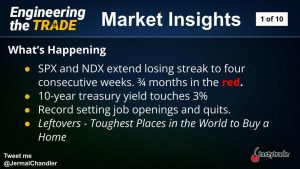Expect Chaos When the VIX Next Breaks Above 40
The VIX has surged into the 30s on six different occasions during the last 12 months, but the infamous “fear gauge” has met strong resistance on each occasion—last closing above 40 in the year 2020.

Volatility continues to reign during the 2022 trading year with the market’s “fear gauge” recently topping 30 for the third time in the last four months.
As of May 4, the CBOE Volatility Index (VIX) was trading around 30, which is roughly 76% higher than where it started the year.
Not coincidentally, the S&P 500 is also trading high and closed trading on May 4 near the lows of the year, at 4,175. The S&P 500 and VIX are highly correlated—but in an inverse fashion—meaning that when the S&P 500 drops, the VIX usually rallies.
The S&P 500 is now down roughly 13% on the year, and since the end of March, has dropped from 4,600 all the way back down to 4,075. It’s that rapid decline in the S&P 500 that has pushed the VIX back up to the 30s.

The stock market staged an impressive intraday reversal on May 2 when the S&P dropped as low as 4,075 and then rallied back above 4,150 in the same trading day. A trading day that highlights the type of movement observed in the stock market throughout the year.
A new key level of support for the S&P 500 has been at 4,075. And whenever the S&P 500 drops through that support, the VIX could finally pop above 40. So far this year, the 30-ish level in VIX has served as a strong point of resistance, much like it did last year.
In 2021, the VIX surged toward 30 three different times between May and November, only to fall back on each occasion. That means over the last 12 months, the VIX has climbed to the 30-area six different times, and failed to break 40 in each instance.
As a result, it’s starting to feel like it might require a major development for the VIX to break above 40—an event, or revelation, that strikes fear in the markets.
For now, options traders may need to ready themselves for a chance to sell volatility should the VIX retrace further, as that may signal that this current bout of volatility has officially subsided.
Previous research conducted by tastytrade has shown that short volatility trades tend to perform better when shortening trade duration during periods of heightened volatility.
To learn more about this tactic, readers are encouraged to review this previous installment of Market Measures on the tastytrade financial network.
For more perspective on the current trading environment, check out these new episodes of Research Corner and Engineering the Trade. Readers can also tune into TASTYTRADE LIVE for daily updates on everything moving the markets.
Sage Anderson is a pseudonym. He’s an experienced trader of equity derivatives and has managed volatility-based portfolios as a former prop trading firm employee. He’s not an employee of Luckbox, tastytrade or any affiliated companies. Readers can direct questions about this blog or other trading-related subjects, to support@luckboxmagazine.com.



















